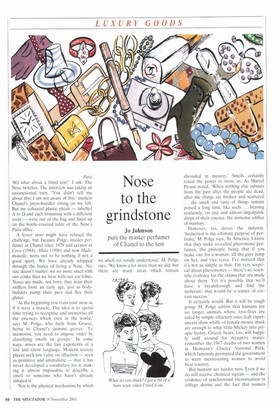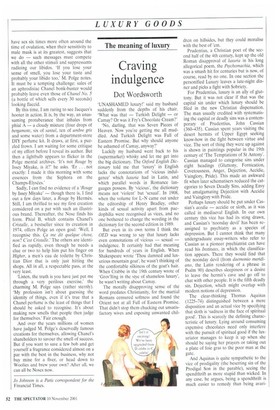Nose to the grindstone
Jo Johnson puts the master perfumer of Chanel to the test
Paris 'SO what about a blind test?' I ask. The Nose twitches. The interview was taking an unsanctioned turn. 'You didn't tell me about this; I am not aware of this,' mutters Chanel's press-handler sitting on my left. But my coloured plastic phials — labelled A to D and each brimming with a different scent — were out of the bag and lined up on the bottle-covered table of the Nose's Paris office.
A lesser man might have refused the challenge, but Jacques Polge, master perfumer at Chanel since 1978 and creator of Coco (1984), Allure (1996) and now Mademoiselle, turns out to be nothing if not a good sport. We have already whipped through the basics of being a Nose. No, size doesn't matter: we no more smell with our conks than we hear with our ear-lobes. Noses are made, not born: they train their sniffers from an early age, just as bodybuilders pump their pecs and flex their glutes.
'At the beginning you train your nose as if it were a muscle. The idea is to spend time trying to recognise and memorise all the essences which exist in the world,' says M. Polge, who hails from Grasse, home to Chanel's jasmine groves. 'To memorise, you need to impose order by classifying smells in groups.' In some ways, noses are the last exponents of a lost and silent language. Modern society places such low value on olfaction — seen as primitive and animalistic — that it has never developed a vocabulary for it, making it almost impossible to describe a smell to someone who hasn't already inhaled it.
'Nor is the physical mechanism by which shrouded in mystery.' Smells certainly retain the power to move us. As Marcel Proust noted, 'When nothing else subsists from the past after the people are dead, after the things are broken and scattered ... the smell and taste of things remain poised a long time, like souls . .. bearing resiliently, on tiny and almost impalpable drops of their essence, the immense edifice of memory.'
However, sex drives the industry. 'Seduction is the ultimate purpose of perfume,' M. Polge says. 'In America, I know that they make so-called pheromone perfumes, the principle being that if you make one for a woman, all the guys jump on her, and vice versa. I've noticed that it's not as simple as that. I'm very sceptical about pheromones — there's no scientific evidence for the claims that are made about them. Yet it's possible that we'll have a breakthrough and find the molecule: that would be a source of certain success.'
It certainly would. But it will be tough going: M. Polge admits that humans are no longer animals whose love-lives are ruled by simple olfactory cues. Lab experiments show whiffs of female-mouse musk are enough to whip little Mickey into priapic frenzy. Grizzly bears, too, will happily sniff around for receptive mates: remember the 1967 deaths of two women in Montana's Glacier National Park, which famously prompted the government to warn menstruating women to avoid bear country.
But humans are harder nuts. Even if we do still receive chemical signals — and the evidence of synchronised menstruation in college dorms and the fact that women have sex six times more often around the time of ovulation, when their sensitivity to male musk is at its greatest, suggests that we do — such messages must compete with all the other stimuli and suppressants radioing our libidos. 'If you lose your sense of smell, you lose your taste and probably your libido too,' M. Polge notes. It must be a tempting challenge: sales of an aphrodisiac Chanel bonk-buster would probably leave even those of Chanel No. 5 (a bottle of which sells every 30 seconds) looking flaccid.
By this time, I am raring to see Jacques's hooter in action. It is, by the way, an unassuming protuberance that inhales from phial A — a cloudy mixture (four drops of bergamote, six of santal, ten of ambre gris and some water) from a department-store DIY perfume kit. It draws, at first, a puzzled frown. I am waiting for some critique of my effort before I reveal its author. But then a lightbulb appears to flicker in the Polge mental archives. 'It's not Rouge by Issey Miyake, is it?' he asks. 'Er . .. not exactly: I made it this morning with some essences from the Sephora on the Champs-Elysées.'
Sadly, I can find no evidence of a 'Rouge by Issey Miyake' — though there is, I find out a few days later, a Rouge by Hermes. Still, I am thrilled to see my first creation considered on a par with such an illustrious brand. Thereafter, the Nose finds his form. Phial B, which contains Chanel's Cristalle, a bestseller since its creation in 1974, offers Polge an open goal: 'Well, I recognise this. Ca me dit quelque chose, non? C'est Cristalle The others are identified as rapidly, even though he needs a clue or two to help him put his finger on Higher, a men's eau de toilette by Christian Dior that is only just hitting the shops. All in all, a respectable pass, at the very least.
'Listen, the truth is you have just put me through a very perilous exercise,' the charming M. Polge says (rather sternly). 'My profession isn't about guessing the identity of things, even if it's true that a Chanel perfume is the least of things that I should be asked to recognise. It's about making new smells that people then judge for themselves.' Fair enough.
And over the years millions of women have judged M. Polge's deservedly famous creations for themselves, allowing Chanel's shareholders to savour the smell of success. But if you want to save a few bob and get yourself a fragrance considered almost on a par with the best in the business, why not buy mine for a fiver, or head down to Woolies and brew your own? After all, we can all be Noses now.
Jo Johnson is a Paris correspondent for the Financial Times.















































































































 Previous page
Previous page